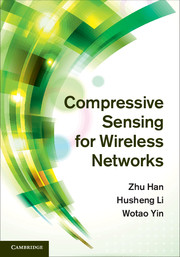6 - Compressed channel estimation
from Part II - CS-Based Wireless Communication
Published online by Cambridge University Press: 05 June 2013
Summary
Introduction and motivation
The wireless channels place fundamental limitations on the performance of many wireless communication systems. A transmitted radio signal propagating from a transmitter to a receiver is generally reflected, scattered, and attenuated by the obstacles in the field. At the receiver, two or more slightly delayed versions of the transmitted signal will superpose together. This so-called fading phenomena in wireless communication channels is a double-edged sword to wireless communication systems [1, 270]. On the one hand, this multipath propagation phenomenon will result in severe fluctuations of the amplitudes, phases and delays of a radio signal over a short period of time or distance. Interpreting the resultant received signals, which vary widely in amplitude and phase, is a critical design challenge to the receiver. On the other hand, multipaths will enhance the time, spatial and frequency diversity of the channel available for communication, which will lead to gains in data transmission and channel reliability. To obtain the diversity gain and alleviate the side effect of the channel fading, knowledge of channel state information (CSI) is necessary. Thus, channel estimation is of significant importance for the transceiver design.
The CS theory [69, 70, 271] is a new technology that has emerged in the area of signal processing, statistics and wireless communication. By utilizing the fact that a signal is sparse or compressible in some transform domain, CS can powerfully acquire a signal from a small set of randomly projected measurements with a sampling rate much lower than the Nyquist sampling rate.
- Type
- Chapter
- Information
- Compressive Sensing for Wireless Networks , pp. 141 - 172Publisher: Cambridge University PressPrint publication year: 2013

